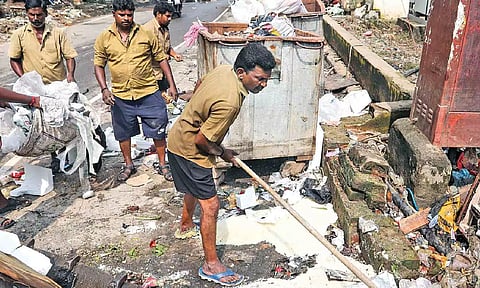

CHENNAI: While denizens continue to grapple with the aftermath of the havoc wreaked by Cyclone Michaung, the government departments in the city have been busy cleaning and clearing.
The Greater Chennai Corporation (GCC) began working on clearing debris, removing waste from clogged drains, repairing damaged roads and public structures.
The Metro Water department needs to undertake testing of drinking water in large numbers and ensure that the safe drinking water is supplied. As there have been several reports of rainwater mixing with sewage water and entering the sumps, the testing needs to be scaled-up and fast tracked.
SWD didn’t work
The civic body spent Rs 2,191 crore to construct storm water drains (SWD) across the city so far but the money seems to have, literally, gone down the drain.
The drains were supposedly completed based on priority areas including Kolathur, Pullainthope, Perambur, Pattalam and Madipakkam, which had been severely affected during the northeast monsoon in 2021. So, the drains were newly constructed and interlinked a few months ago.
However, the SWDs did not help to prevent inundation due to Cyclone Michaung. A committee was formed under the leadership of retired IAS officer V Thiruppugazh, where the team inspected the flood-prone areas in the city that were impacted in 2021. Based on the report they had submitted in May 2022, the flood mitigation work was carried out and SWDs were constructed.
Earlier, 2,073 km of existing drains were built across the city and this year, an additional of 879 km new SWDs were constructed at an estimated cost of over Rs 2,000 crore. “The newly-constructed SWDs did not prevent even 30-40% of water-logging. This year, when the city experienced mild showers during the southwest and northeast monsoon seasons, there was no water-logging in the city, and the stagnated rainwater flowed through the existing SWDs. This had given us hope that we’d be free from inundation but it ended up flooding the entire city,” explained J Krishna, a resident of Perambur.
No interlinking
Pattalam residents pointed out that though the Corporation had constructed new SWDs, the contractor had failed to interlink them, which led to flooding.
“There’s no point in constructing new drains without linking them to waterbodies, as the rainwater flowing through the SWDs reversed and flooded the entire area. What happened this year feels like a repeat of the deluge in 2021 and 2015,” lamented a resident.
The public pointed out that instead of trying to complete the construction within a short duration, the GCC could have started as soon as the monsoon withdrew from the State.
There seems to be a lack of coordination between contractors and civic authorities, alleged a resident of Tambaram. “There was 4-5 feet of water inside many homes here. We did not face this even during the floods in 2015. The most difficult part is cleaning the house, which would take over 2 weeks. We’ve lost documents, appliances and vehicles.”
Drains not desilted
Residents rued that the civic body had failed to carry out flood-mitigation works including desilting drains, which clogged the drainage system with waste – one of the main reasons for inundation, as the water could not flow through the SWDs and reach water-bodies.
After the northeast monsoon ends, the public urge the authorities to rectify the issues, instead of blaming the cyclone’s intensity.
The GCC mentioned that the State government had allocated Rs 5,166 crore for SWD construction across the city. So far, it has completed the work of Rs 2,191 crore. “We’ve completed SWDs in core areas in the city. However, the level in waterbodies increased which prevented the flow of excess rainwater into lakes and rivers. Steps have been taken to address it, and the SWD work will be resumed after the monsoon ends,” said a senior official.
Groundwater contamination
The civic body has been focused on pumping out stagnated rainwater and rescuing residents from inundated areas in the city.
Though hundreds were rescued, they have raised concerns over overflowing sewage, which has become a common issue during the monsoon season. They complain that groundwater has been contaminated and mixed with sewage, and cannot be consumed or used for domestic purposes.
D Aarthi, a resident of Valasavakkam, fumed that the government had not taken steps to remove stagnated water outside her home till now. “Rainwater mixed with sewage, and entered my house. We have to replace everything because my house was flooded. None of the appliances, furniture, clothes, utensils, etc., can be used,” she said.
Residents also lamented over the shoddy work of the Metro Water board. One of the common issues in the city is sewage overflow and contaminated drinking water, which have not been addressed for over a decade.
“After multiple complaints, the Metro Water board took steps to pump out the stagnated sewage on the road. However, instead of disposing it in the allotted places, workers let it out into the SWDs, despite regulations that they should be used only to let out excess rainwater. Eventually, we’re the affected people when heavy rain hits the city,” rued V Sathiabalan, a resident and civic activist of Perambur Barracks road in Pattalam.
Metro Water board says...
The Chennai Metropolitan Water Supply and Sewerage Board (CMWSSB) has ensured that the overflowing sewage and stagnation has been rectified in many areas.
The official mentioned that after the monsoon, desilting of sewage pipelines will be carried out across the city. “We’ve also increased the number of drinking water samples from 300 to 600 during the northeast monsoon. It might take a week or two to get the results. We would provide free drinking water through truck lorries, pipelines and refill the tanks in the city to ensure uninterrupted drinking water in the city,” explained a senior official.